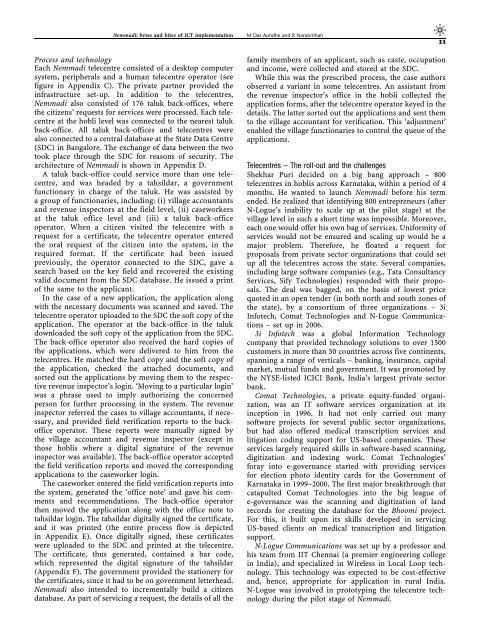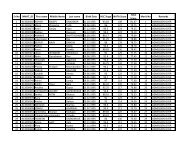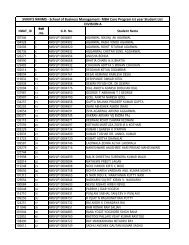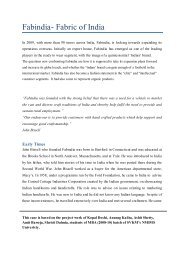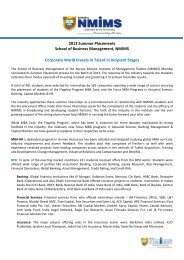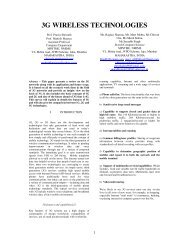Dr.-Ramesh-Narasimhan-Case-study-on-ICT-Adoption - NMIMS
Dr.-Ramesh-Narasimhan-Case-study-on-ICT-Adoption - NMIMS
Dr.-Ramesh-Narasimhan-Case-study-on-ICT-Adoption - NMIMS
You also want an ePaper? Increase the reach of your titles
YUMPU automatically turns print PDFs into web optimized ePapers that Google loves.
Nemmadi: bytes and bites of <strong>ICT</strong> implementati<strong>on</strong> M Das Aundhe and R <str<strong>on</strong>g>Narasimhan</str<strong>on</strong>g><br />
Process and technology<br />
Each Nemmadi telecentre c<strong>on</strong>sisted of a desktop computer<br />
system, peripherals and a human telecentre operator (see<br />
figure in Appendix C). The private partner provided the<br />
infrastructure set-up. In additi<strong>on</strong> to the telecentres,<br />
Nemmadi also c<strong>on</strong>sisted of 176 taluk back-offices, where<br />
the citizens’ requests for services were processed. Each telecentre<br />
at the hobli level was c<strong>on</strong>nected to the nearest taluk<br />
back-office. All taluk back-offices and telecentres were<br />
also c<strong>on</strong>nected to a central database at the State Data Centre<br />
(SDC) in Bangalore. The exchange of data between the two<br />
took place through the SDC for reas<strong>on</strong>s of security. The<br />
architecture of Nemmadi is shown in Appendix D.<br />
Atalukback-officecouldservicemorethan<strong>on</strong>etelecentre,<br />
and was headed by a tahsildar, a government<br />
functi<strong>on</strong>ary in charge of the taluk. He was assisted by<br />
a group of functi<strong>on</strong>aries, including: (i) village accountants<br />
and revenue inspectors at the field level, (ii) caseworkers<br />
at the taluk office level and (iii) a taluk back-office<br />
operator. When a citizen visited the telecentre with a<br />
request for a certificate, the telecentre operator entered<br />
the oral request of the citizen into the system, in the<br />
required format. If the certificate had been issued<br />
previously, the operator c<strong>on</strong>nected to the SDC, gave a<br />
search based <strong>on</strong> the key field and recovered the existing<br />
valid document from the SDC database. He issued a print<br />
of the same to the applicant.<br />
In the case of a new applicati<strong>on</strong>, the applicati<strong>on</strong> al<strong>on</strong>g<br />
with the necessary documents was scanned and saved. The<br />
telecentre operator uploaded to the SDC the soft copy of the<br />
applicati<strong>on</strong>. The operator at the back-office in the taluk<br />
downloaded the soft copy of the applicati<strong>on</strong> from the SDC.<br />
The back-office operator also received the hard copies of<br />
the applicati<strong>on</strong>s, which were delivered to him from the<br />
telecentres. He matched the hard copy and the soft copy of<br />
the applicati<strong>on</strong>, checked the attached documents, and<br />
sorted out the applicati<strong>on</strong>s by moving them to the respective<br />
revenue inspector’s login. ‘Moving to a particular login’<br />
was a phrase used to imply authorizing the c<strong>on</strong>cerned<br />
pers<strong>on</strong> for further processing in the system. The revenue<br />
inspector referred the cases to village accountants, if necessary,<br />
and provided field verificati<strong>on</strong> reports to the backoffice<br />
operator. These reports were manually signed by<br />
the village accountant and revenue inspector (except in<br />
those hoblis where a digital signature of the revenue<br />
inspector was available). The back-office operator accepted<br />
the field verificati<strong>on</strong> reports and moved the corresp<strong>on</strong>ding<br />
applicati<strong>on</strong>s to the caseworker login.<br />
The caseworker entered the field verificati<strong>on</strong> reports into<br />
the system, generated the ‘office note’ and gave his comments<br />
and recommendati<strong>on</strong>s. The back-office operator<br />
then moved the applicati<strong>on</strong> al<strong>on</strong>g with the office note to<br />
tahsildar login. The tahsildar digitally signed the certificate,<br />
and it was printed (the entire process flow is depicted<br />
in Appendix E). Once digitally signed, these certificates<br />
were uploaded to the SDC and printed at the telecentre.<br />
The certificate, thus generated, c<strong>on</strong>tained a bar code,<br />
which represented the digital signature of the tahsildar<br />
(Appendix F). The government provided the stati<strong>on</strong>ery for<br />
the certificates, since it had to be <strong>on</strong> government letterhead.<br />
Nemmadi also intended to incrementally build a citizen<br />
database. As part of servicing a request, the details of all the<br />
33<br />
family members of an applicant, such as caste, occupati<strong>on</strong><br />
and income, were collected and stored at the SDC.<br />
While this was the prescribed process, the case authors<br />
observed a variant in some telecentres. An assistant from<br />
the revenue inspector’s office in the hobli collected the<br />
applicati<strong>on</strong> forms, after the telecentre operator keyed in the<br />
details. The latter sorted out the applicati<strong>on</strong>s and sent them<br />
to the village accountant for verificati<strong>on</strong>. This ‘adjustment’<br />
enabled the village functi<strong>on</strong>aries to c<strong>on</strong>trol the queue of the<br />
applicati<strong>on</strong>s.<br />
Telecentres – The roll-out and the challenges<br />
Shekhar Puri decided <strong>on</strong> a big bang approach – 800<br />
telecentres in hoblis across Karnataka, within a period of 4<br />
m<strong>on</strong>ths. He wanted to launch Nemmadi before his term<br />
ended. He realized that identifying 800 entrepreneurs (after<br />
N-Logue’s inability to scale up at the pilot stage) at the<br />
village level in such a short time was impossible. Moreover,<br />
each <strong>on</strong>e would offer his own bag of services. Uniformity of<br />
services would not be ensured and scaling up would be a<br />
major problem. Therefore, he floated a request for<br />
proposals from private sector organizati<strong>on</strong>s that could set<br />
up all the telecentres across the state. Several companies,<br />
including large software companies (e.g., Tata C<strong>on</strong>sultancy<br />
Services, Sify Technologies) resp<strong>on</strong>ded with their proposals.<br />
The deal was bagged, <strong>on</strong> the basis of lowest price<br />
quoted in an open tender (in both north and south z<strong>on</strong>es of<br />
the state), by a c<strong>on</strong>sortium of three organizati<strong>on</strong>s – 3i<br />
Infotech, Comat Technologies and N-Logue Communicati<strong>on</strong>s<br />
– set up in 2006.<br />
3i Infotech was a global Informati<strong>on</strong> Technology<br />
company that provided technology soluti<strong>on</strong>s to over 1500<br />
customers in more than 50 countries across five c<strong>on</strong>tinents,<br />
spanning a range of verticals – banking, insurance, capital<br />
market, mutual funds and government. It was promoted by<br />
the NYSE-listed ICICI Bank, India’s largest private sector<br />
bank.<br />
Comat Technologies, a private equity-funded organizati<strong>on</strong>,<br />
was an IT software services organizati<strong>on</strong> at its<br />
incepti<strong>on</strong> in 1996. It had not <strong>on</strong>ly carried out many<br />
software projects for several public sector organizati<strong>on</strong>s,<br />
but had also offered medical transcripti<strong>on</strong> services and<br />
litigati<strong>on</strong> coding support for US-based companies. These<br />
services largely required skills in software-based scanning,<br />
digitizati<strong>on</strong> and indexing work. Comat Technologies’<br />
foray into e-governance started with providing services<br />
for electi<strong>on</strong> photo identity cards for the Government of<br />
Karnataka in 1999–2000. The first major breakthrough that<br />
catapulted Comat Technologies into the big league of<br />
e-governance was the scanning and digitizati<strong>on</strong> of land<br />
records for creating the database for the Bhoomi project.<br />
For this, it built up<strong>on</strong> its skills developed in servicing<br />
US-based clients <strong>on</strong> medical transcripti<strong>on</strong> and litigati<strong>on</strong><br />
support.<br />
N-Logue Communicati<strong>on</strong>s was set up by a professor and<br />
his team from IIT Chennai (a premier engineering college<br />
in India), and specialized in Wireless in Local Loop technology.<br />
This technology was expected to be cost-effective<br />
and, hence, appropriate for applicati<strong>on</strong> in rural India.<br />
N-Logue was involved in prototyping the telecentre technology<br />
during the pilot stage of Nemmadi.


